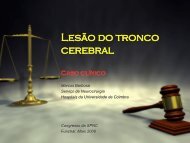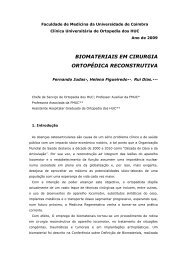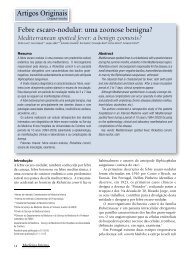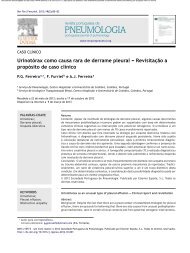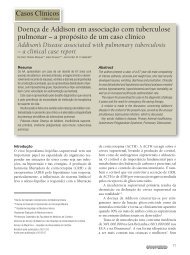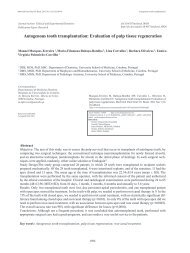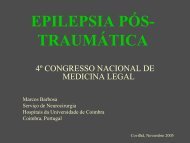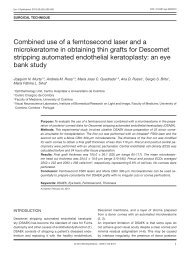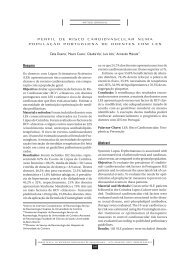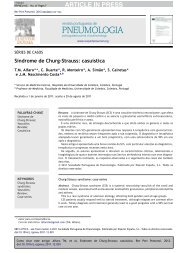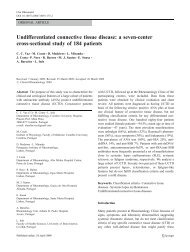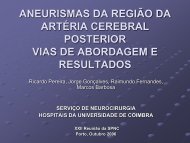Severe intracranial haemorrhage in neonatal alloimmune ... - RIHUC
Severe intracranial haemorrhage in neonatal alloimmune ... - RIHUC
Severe intracranial haemorrhage in neonatal alloimmune ... - RIHUC
You also want an ePaper? Increase the reach of your titles
YUMPU automatically turns print PDFs into web optimized ePapers that Google loves.
TREATMENT<br />
Medical treatment was started <strong>in</strong> the first hours of life<br />
( figure 3 ). Due to the unavailability of compatible platelets<br />
(negative HPA-1a), two platelet transfusions (20 ml/<br />
kg/dose) from random donors were adm<strong>in</strong>istered <strong>in</strong> day<br />
1 with count normalisation. IVIG (1 g/kg/day for 2 days)<br />
and <strong>in</strong>travenous methylprednisolone (3 mg/kg/day for 5<br />
days) were adm<strong>in</strong>istered as adjunctive therapies. Despite<br />
this management and over the next 3 days, platelet count<br />
decreased (28×10 9 /l platelets) lead<strong>in</strong>g to a third compatible<br />
platelet transfusion (negative HPA-1a donor) and IVIG<br />
adm<strong>in</strong>istration.<br />
OUTCOME AND FOLLOW-UP<br />
Platelet count reached a normal plateau (>198×10 9 /l platelets),<br />
signs of sk<strong>in</strong> bleed<strong>in</strong>g improved and cranial ultrasound<br />
was resemblant, at 5 days of life. Bra<strong>in</strong> MRI on day<br />
8 ( figure 4 ) showed multiple subacute cerebral <strong>haemorrhage</strong>s<br />
(1–4 weeks of development) <strong>in</strong> the right parietal<br />
lobe and <strong>in</strong> the posterior fossa, signs of chronic bleed<strong>in</strong>g<br />
(haemosider<strong>in</strong> deposits) <strong>in</strong> the occipital lobes and cerebellar<br />
hemispheres and vermis, these last also present<strong>in</strong>g<br />
marked atrophy.<br />
At day 11 of life, she was discharged home without<br />
cl<strong>in</strong>ical manifestations of neither bleed<strong>in</strong>g nor focal deficits<br />
on neurological exam<strong>in</strong>ation. Platelet count was normal<br />
(222×10 9 /l platelets).<br />
At 3 weeks life <strong>in</strong> the paediatric haematology consultation,<br />
molecular study was performed show<strong>in</strong>g homozygous<br />
platelet alloantigen genotypes 1b/1b <strong>in</strong> the mother and<br />
1a/1a <strong>in</strong> the father; the newborn was proved to be heterozygous<br />
HPA-1a/1b. Genetic counsell<strong>in</strong>g was offered.<br />
DISCUSSION<br />
Any newborn <strong>in</strong>fant with platelet count below 100×10 9 /l<br />
should be considered abnormal and promptly studied for<br />
an underly<strong>in</strong>g cause. 3 NAIT is a rare severe condition. It<br />
must be suspected if cl<strong>in</strong>ical manifestations such as sk<strong>in</strong><br />
or gastro<strong>in</strong>test<strong>in</strong>al bleed<strong>in</strong>g or <strong><strong>in</strong>tracranial</strong> <strong>haemorrhage</strong><br />
on ultrasound and severe thrombocytopenia are present,<br />
<strong>in</strong> the absence of maternal thrombocytopenia. Because<br />
maternal screen<strong>in</strong>g is rarely performed, couples usually<br />
do not know they are at risk until they have delivered an<br />
affected child. 1 3 5 The mother is asymptomatic, yet she or<br />
a sister may have a history of earlier affected pregnancies. 4<br />
In the previous case there was a history of spontaneous<br />
abortion 1 year earlier, after an amniocentesis at 16 weeks<br />
of pregnancy. This episode could have been related to foetal<br />
<strong>alloimmune</strong> thrombocytopenia. An explanation is that<br />
fetal platelet antigens are expressed s<strong>in</strong>ce week 16 of gestation<br />
enter<strong>in</strong>g the maternal circulation. Antiplatelet antibodies<br />
can endure <strong>in</strong> maternal circulation for many years<br />
and additional exposure <strong>in</strong> subsequent pregnancies can be<br />
a further stimulus. Severity of NAIT tends to worsen with<br />
subsequent pregnancies, lead<strong>in</strong>g to an <strong>in</strong>creased risk for<br />
<strong><strong>in</strong>tracranial</strong> <strong>haemorrhage</strong>. 1 4 In our case, bra<strong>in</strong> MRI showed<br />
that although undetected <strong>in</strong> fetal ultrasound, <strong><strong>in</strong>tracranial</strong><br />
<strong>haemorrhage</strong> occurred <strong>in</strong> utero.<br />
Infants with NAIT and <strong><strong>in</strong>tracranial</strong> <strong>haemorrhage</strong> have<br />
the poorest outcome. Mortality can range from 15% to<br />
30% of these cases. 4 6 Non-fatal cases usually are associated<br />
with neurologic sequelae <strong>in</strong>clud<strong>in</strong>g cerebral palsy,<br />
mental retardation, cortical bl<strong>in</strong>dness and seizures. When<br />
<strong><strong>in</strong>tracranial</strong> <strong>haemorrhage</strong> occurs <strong>in</strong> utero before week 20,<br />
abnormalities like porencephalic cysts, hydrocephaly, neuronal<br />
migrational disorders and superficial siderosis are<br />
often present. 4 Due to the severe central nervous system<br />
abnormalities affect<strong>in</strong>g the motor and coord<strong>in</strong>ation centers<br />
<strong>in</strong> our case, some compromise <strong>in</strong> the neurodevelopment is<br />
expected.<br />
The treatment of severe NAIT with platelet transfusion<br />
takes <strong>in</strong>to account the threshold of the platelet count. Term<br />
newborns with less than 30×10 9 /l platelets and preterm<br />
<strong>in</strong>fants with less than 50×10 9 /l platelets should be transfused,<br />
especially if bleed<strong>in</strong>g is present. Intravenous γ-globul<strong>in</strong> (1 g/<br />
kg/day for 1–4 days) is effective <strong>in</strong> 75% of cases but takes<br />
longer than does a platelet transfusion to achieve a safe<br />
platelet count. Intravenous methylprednisolone (1 mg/kg, q<br />
8 h, 1–3 days) lacks on efficacy studies. 1 4<br />
Because of the high risk of recurrence of NAIT, all women<br />
with a history of NAIT must be counselled. Sisters of HPA-<br />
1a–negative women should also be tested. 2 4 Attend<strong>in</strong>g the<br />
father’s homozygous genotype <strong>in</strong> the previous case, this<br />
couple will always produce HPA-1a/1b <strong>in</strong>fants, who will<br />
be affected by this condition if antenatal management is<br />
not fulfilled. Although the severity of NAIT is often difficult<br />
to predict, it is known that it tends to worsen with<br />
subsequent pregnancies. 4 Bussel et al. showed that a history<br />
of <strong><strong>in</strong>tracranial</strong> <strong>haemorrhage</strong> <strong>in</strong> a previously affected sibl<strong>in</strong>g<br />
is the only significant predictor of severity. 7 For this reason,<br />
if this couple decides to proceed with a future pregnancy<br />
they must be closely monitored and treatment should be<br />
offered. In a couple with a previous affected <strong>in</strong>fant, adequate<br />
therapy is maternal weekly IVIG from 20 weeks of<br />
gestation or earlier (12 weeks) if <strong><strong>in</strong>tracranial</strong> <strong>haemorrhage</strong><br />
is present. Increase of the IVIG dose or daily prednisone<br />
may be used when a more <strong>in</strong>tense prevention strategy is<br />
needed. Maternal anti-HPA-1a antibodies should be monitored.<br />
Antenatal management should avoid <strong>in</strong>vasive procedures<br />
such as <strong>in</strong> utero platelet transfusions because of<br />
the high risk of fetal loss (5.5% per affected pregnancy).<br />
Elective caesarean delivery should be performed, m<strong>in</strong>imis<strong>in</strong>g<br />
the haemorrhagic risks. 2 4 8<br />
Learn<strong>in</strong>g po<strong>in</strong>ts<br />
▶ Suspect of NAIT <strong>in</strong> a well newborn who presents with<br />
bruis<strong>in</strong>g, petechial rash and/or suffusions and who is<br />
found to have isolated severe thrombocytopenia.<br />
▶ Careful <strong>in</strong>quire about maternal personal and familial<br />
history and obstetric follow-up, <strong>in</strong>clud<strong>in</strong>g maternal<br />
platelet count.<br />
▶ Treatment should <strong>in</strong>clude adequate platelet transfusion<br />
(HPA-1a/ HPA-5b negative platelets) and IVIG as earlier<br />
as possible to prevent bleed<strong>in</strong>g complications. If<br />
adequate platelet transfusion is not available, random<br />
donor platelets should be used.<br />
▶ Intracranial <strong>haemorrhage</strong> is the most serious<br />
complication with catastrophic neurologic sequelae.<br />
▶ Genetic counsell<strong>in</strong>g should be offered to couples of<br />
affected children who want to have future pregnancies.<br />
Antenatal management is crucial <strong>in</strong> prevention of a<br />
poor outcome.<br />
4 of 5<br />
BMJ Case Reports 2011; doi:10.1136/bcr.07.2011.4563




